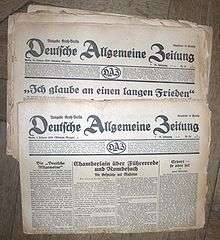Deutsche Allgemeine Zeitung

Deutsche Allgemeine Zeitung (often abbreviated to DAZ) was a German newspaper that appeared between 1861 and 1945.
Until 1918 the title of the paper was Norddeutsche Allgemeine Zeitung. Although Wilhelm Liebknecht, one of the founders of SPD and close associate of Karl Marx and Friedrich Engels, was member of the founding editorial board in 1861, the paper became soon a conservative flagship of the German press ("Bismarcks Hauspostille"). At the end of the First World War, the name was changed to "Deutsche Allgemeine Zeitung", under the intention to form a conservative yet democratic equivalent to the London "Times" in Germany and give the Reich a more democratic image. Various liberal and conservative writers worked for DAZ at that time, Otto Flake was head of the Cultural Section ( called "Feuilleton" in German newspapers ), people like the historian Egmont Zechlin, the German-Turkish journalist Dr. Friedrich Schrader and his Swiss colleague from Constantinople Max Rudolf Kaufmann worked for the paper.
Hugo Stinnes took over the DAZ in 1920 in an effort to secure industrialist influence. Stinnes invested in the newspaper, and it enjoyed a short period of financial success. The DAZ became increasingly conservative. Paul Lensch, a former left-wing Social Democrat associated with Rosa Luxemburg, later during the war part of the right wing "Lensch-Cunow-Haenisch-Gruppe" within the SPD (itself associated with and financed by the German-Russian-Jewish socialist revolutionary Alexander Parvus), became foreign policy editor, and later editor in chief of DAZ, which he edited until his death in 1926.
After the death of Lensch, until when the paper was a conservative supporter of the Weimar coalition (Stinnes was associated with Gustav Stresemann and his DVP), the paper became, like the DVP itself, incleasingly right wing and closer to the Hugenberg press and anti-democratic right-wing circles.
After Stinnes' (and Lensch's) death, the Prussian government secretly bought the DAZ in 1925. Less than a year later, the Reich government took it over, but it was sold again when the affair came to light.[1]
By 1930, the DAZ had declined and was suffering heavy losses.[1]
References
External links
| Wikisource has original text related to this article: |